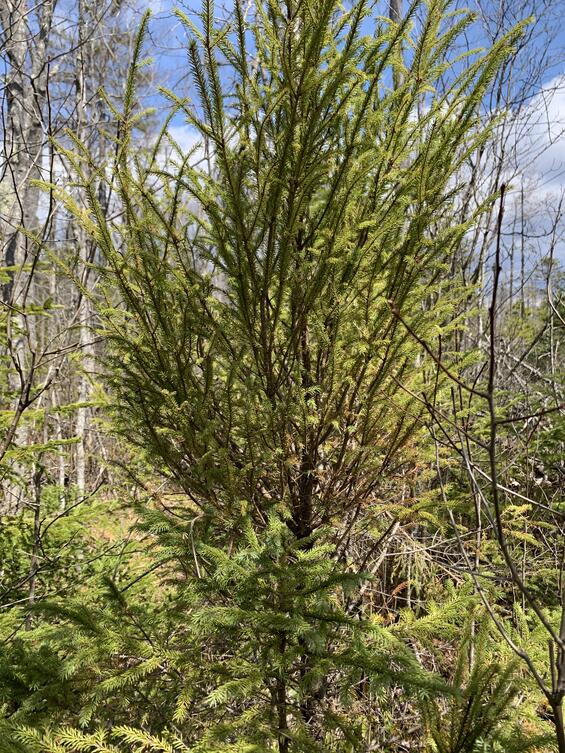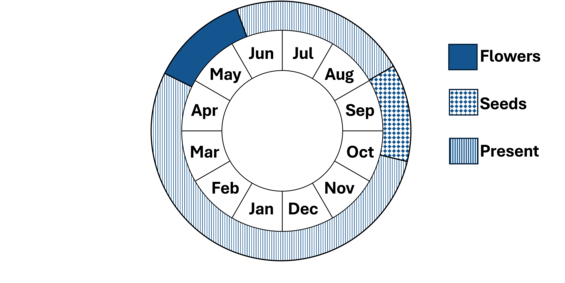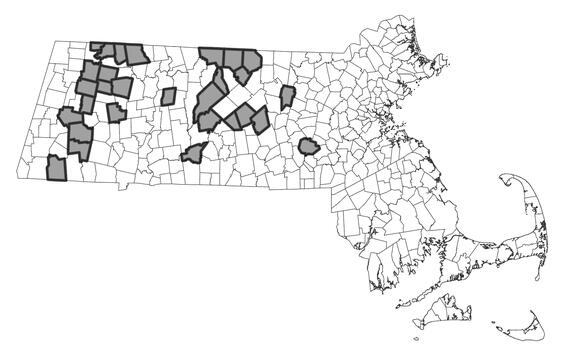- Scientific name: Arceuthobium pusillum Peck
- Species of Greatest Conservation Need (MA State Wildlife Action Plan)
- Special Concern (MA Endangered Species Act)
Description
Eastern dwarf mistletoe (Arceuthobium pusillum) is a member of the Christmas Mistletoe family (Viscaceae). It is a very small fleshy shrub, usually no more than 2 cm (0.8 in) tall that parasitizes conifer trees, primarily black spruce, red spruce, and larch in Massachusetts. Rarely, it may also infect balsam fir (Abies balsamea), Jack pine (Pinus banksiana), red pine (Pinus resinosa), or white pine (Pinus strobus). Its generic name reflects this parasitic habit, coming from the Greek words for juniper (arkeuthos) and life (bios). This simple or sparingly branched plant has greenish to chestnut-colored, or even purplish, stems that are circular when fresh and four-angled when dry. The opposite leaves are reduced to thin, connate, obtuse (blunt tipped) scales with a width of only 1 mm (0.04 in). Eastern dwarf mistletoe spreads beneath the bark of its host by means of a haustoria, an organ used to obtain nutrients from the host. The formation of globose clumps of swollen, infected branches or “witches’ brooms” saps the trees’ strength and, eventually, a tree covered with them may weaken and die.

Witch's broom (Photo by Peter Grima)
Life cycle and behavior
Eastern dwarf mistletoe is a dioecious plant (a plant with unisexual flowers in which the individual plants are either male or female). Dwarf mistletoes disperse by expelling their seeds in September or early October from explosive fruits, sending the seeds up to 30 feet. If the sticky seed is lucky enough to land on an appropriate host tree, it clings to needles, eventually sliding down the needle to germinate on a twig during the following spring. Once it germinates, it forms an extensive root-like system that penetrates and spreads under the bark and develops food and water transport systems. An aerial fruiting structure arises in the early spring of the second year. The structure is green and about as long as a spruce needle. Male and female plants are located on separate branches or on separate trees. During the third year, flowers are produced from April to early June. Male (pollen-producing) flowers, which survive only a short time, have 3 or 4 petals, and are large and orange-yellow. Pollen is spread to the tiny female flowers by wind, insects, and birds. Each female flower then bears one barrel-shaped fruit. Dobbs (2022) reports that Baker et al. (1985) studied the pollination of the dwarf mistletoe flowers. The flowers of dwarf mistletoe have characteristics of both wind and insect-pollinated plants and concluded that insect pollination was of greater importance to this species. The fruit, which matures in September to October, contains a hard seed covered with a sticky substance. The seed is shot out of the coat and may land on a neighboring tree. The fruiting structure then withers and falls off, leaving only the cup-shaped base. Seeds may also stick and be carried on the feathers of birds and the fur of mammals. Animals may be helpful for the rare, long-distance dispersal of this species to new locations. Eastern dwarf mistletoe will only germinate on live host branches.

Population status
Eastern dwarf mistletoe is currently listed as a Species of Special Concern in Massachusetts. All listed species are protected from killing, collecting, possessing, or sale and from activities that would destroy their habitat and thus directly or indirectly cause mortality or disrupt critical behaviors. There are 35 populations which have been observed in the past 25 years (1999-2024) and 12 historical stations (unverified since 1999). Of the most recent populations, at least 15 have populations of 50 or more plants, or over 10 infected host plants in a moderate to large wetland supporting spruce. The distribution of eastern dwarf mistletoe is determined by the presence of its hosts, frequently black spruce, which themselves are limited in distribution in Massachusetts. Due to its inconspicuous size, it is likely that some occurrences have gone undiscovered. It is currently known to occur in Berkshire, Franklin, Hampden, Hampshire, Middlesex and Worcester counties. Previously, it also was known to occur in Essex county.
Distribution and abundance
Eastern dwarf mistletoe, one of the most widespread of the New World species of Arceuthobium, is found throughout most of the range of its hosts. The documented range of eastern dwarf mistletoe extends from Newfoundland Island and Quebec west to Minnesota and Saskatchewan and south to northern New Jersey and Pennsylvania. Eastern dwarf mistletoe is considered rare in Connecticut, New Jersey, New York, Pennsylvania, Rhode Island, and Vermont. It is also considered rare in the Canadian province of Saskatchewan.

Distribution in Massachusetts
1999-2024
Based on records in the Natural Heritage Database
Habitat
In Massachusetts, eastern dwarf mistletoe occurs in peatlands varying from kettlehole peat bogs to spruce-fir-birch headwater swamps, generally on the branches of black spruce (Picea mariana). Elsewhere in its range, this plant occasionally occurs on red spruce (Picea rubens), white spruce (Picea glauca) and larch (Larix laricina). Throughout its range, it favors wetland communities dominated by conifer trees and influenced by acidic water. Specific habitats in Massachusetts include acidic conifer swamps, bog forests, and headwater swamps, including a headwater seepage swamp with both acidic and calciphilic plants. In addition to black spruce, associated species include larch (Larix laricina), balsam fir (Abies balsamea), yellow birch (Betula alleghaniensis), hemlock (Tsuga canadensis), red maple (Acer rubrum), bog laurel (Kalmia polifolia) and Labrador tea (Rhododendron groenlandicum). It is absent from drier upland habitats.
Healthy habitats are vital for supporting native wildlife and plants. Explore habitats and learn about conservation and restoration in Massachusetts.
Threats
The continued presence of dwarf mistletoe in Massachusetts is dependent on the health of its primary host, black spruce. Any change to the occurrence of black spruce is likely to impact dwarf mistletoe, including changes in hydrology, deforestation, or disease impacting black spruce. Fortunately, black spruce populations are currently stable throughout our state. However, black spruce might be impacted by climate change as it is likely Massachusetts will receive extremes in rainfall as well as severe droughts (Staudinger et al., 2024). Climatic stressors are likely to negatively impact the host tree, potentially reducing its populations. Black spruce, particularly as seedlings, are known to be susceptible to heat stress and drought. The health of black spruce populations rely on mycorrhizal fungus, and there is little to no information of climate change impact on that species.
The presence of the host species in appropriate habitat does not guarantee the presence of dwarf mistletoe. More than half the seeds produced by dwarf mistletoe do not successfully land on a twig of an appropriate species that is less than five years old. Some land on the ground, and some are destroyed by fungus and insects. Some landing on appropriate species are subsequently dislodged by precipitation, and never germinate (Hawksworth and Wiens 1996).
Conservation
Survey and monitoring
Many surveys of this species tend to be limited in scope. We do not have an accurate picture of the extent of the population at many sites. Black spruce are growing in wet habitats, sometimes near open water, and maneuvering in those habitats can be difficult. However, dwarf mistletoe can be surveyed in any season as it is distinctive and not easily confused with any other species if observed on branches of spruce or larch. Unless one is in a known population in Massachusetts, it is unlikely that seeing a witch’s broom represents dwarf mistletoe as the vast majority of “witch's brooms” seen are caused by other parasites or disease.
Management
Various species of Arceuthobium are the only flowering plants that produce the phenomenon known as “witch’s broom” on other trees. However, witch’s brooms may also be caused by other parasites, such as fungi and mites, this deformity can eventually kill the affected branches and, later, the entire tree. While eastern dwarf mistletoe is considered to be a serious threat by foresters in eastern Canada and the Lake states, it is not a problem in New England, where its rarity has resulted in its being placed on four state’s rare species lists.
The distribution of eastern dwarf mistletoe is limited by that of its host species in Massachusetts, primarily black spruce. Hence, to preserve a local population, it may be necessary to ensure that its host population persists in the immediate vicinity. All active management of rare plant populations (including invasive species removal) is subject to review under the Massachusetts Endangered Species Act and should be planned in close consultation with the Massachusetts Natural Heritage & Endangered Species Program.
Research needs
The impact of climate change on this diminutive species is not known. Known populations have already decreased in states to the south where it is listed as rare (Dodds 2022). It is known that black spruce, the host species, relies on mycorrhizal fungi, but little is known about its presence in areas, and how that impacts dwarf mistletoe.
References
Baker, F. A., D. W. French, H. M. Kulman, O. Davis and R. C. Bright. 1985. Pollination of the eastern dwarf mistletoe. Canadian Journal of Forest Research 15(4): 708–714, cited in Dobbs, 2022.
Dodds, Jill S. 2022. Arceuthobium pusillum Rare Plant Profile. New Jersey Department of Environmental Protection, State Parks, Forests & Historic Sites, State Forest Fire Service & Forestry, Office of Natural Lands Management, New Jersey Natural Heritage Program, Trenton, NJ. 15 pp.
Gleason, Henry A., and Arthur Cronquist. Manual of Vascular Plants of Northeastern United States
and Adjacent Canada, Second Edition. Bronx, NY: The New York Botanical Garden, 1991.
Haines, Arthur. Flora Novae Angliae. New England Wild Flower Society, Yale University Press, New Haven, CT. 2011.
Hawksworth, Frank G. and Delbert Wiens. 1996. Dwarf mistletoes: Biology, pathology and systematics. USDA Agricultural Handbook 709. PDF Available at https://www.fs.usda.gov/rmrs/publications/dwarf-mistletoes-biology-pathology-and-systematics
NatureServe. 2025. NatureServe Network Biodiversity Location Data accessed through NatureServe Explorer [web application]. NatureServe, Arlington, Virginia. Available https://explorer.natureserve.org/. Accessed: 2/10/2025.
POWO (2025). "Plants of the World Online. Facilitated by the Royal Botanic Gardens, Kew. Published on the Internet; https://powo.science.kew.org/ Retrieved 10 February 2025."
Staudinger, M.D., A.V. Karmalkar, K. Terwilliger, K. Burgio, A. Lubeck, H. Higgins, T. Rice, T.L. Morelli, A. D'Amato. 2024. A regional synthesis of climate data to inform the 2025 State Wildlife Action Plans in the Northeast U.S. DOI Northeast Climate Adaptation Science Center Cooperator Report. 406 p. https://doi.org/10.21429/t352-9q86
Contact
| Date published: | March 20, 2025 |
|---|
